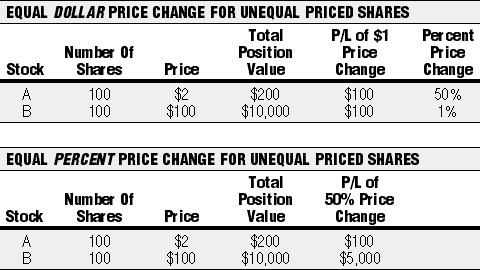NEW TECHNIQUES
Using A Constant Investment Size For Stock Trading Systems
by Jack Schwager
The highest high to the lowest low in the price history of an individual stock can vary tremendously, especially when stock splits occur. This large range of price history can distort the returns of a trading system. This noted analyst explains the steps to adjusting stock data to avoid these distortions.

Not so fast! Although stock price data can be used without modification, doing so without an additional adjustment can lead to enormous distortions. Most of those testing trading systems on stock data commit a major error. The crux of the problem? When a system is tested, the implicit assumption is that each trade is for the same share size. Imagine testing a system on a portfolio of stocks ranging in price from $2 to $100. Would it be reasonable to test the system using an assumption of equal share size in all markets?FIGURE 1: A SHARE IS NOT A SHARE. Here are the consequences of trading two disparately priced stocks in the same position size. As can be seen in the top table, an equal dollar-price change in each stock would have an equal impact on profit/loss but represent a 50% change in the low-priced stock and only a 1% price change in the high-priced stock. The lower table shows that an equal percent-price change in each stock would have 50 times the dollar impact in the high-priced stock as in the low-priced stock. It makes no sense to trade stocks priced at widely disparate levels in the same position size.
Figure 1 illustrates the consequences of trading two disparately priced stocks ($2 and $100) in the same position size. As can be seen in the top table, an equal dollar-price change in each stock would have an equal impact on profit/loss but represent a 50% change in the low-priced stock and only a 1% price change in the high-priced stock. The lower table shows that an equal percent-price change in each stock would have 50 times the dollar impact in the high-priced stock as in the low-priced stock. It makes no sense to trade stocks priced at widely disparate levels in the same position size.
The same mistake occurs when testing an individual stock because of the huge ratio of the highest high to the lowest low in the data range. For example, a $1 move in Disney when the stock is $1 represents a 100% price change, while a $1 move when the stock is at $100 represents a 1% price change. It doesn't make any sense for these two events to have the same impact on the system's profit/loss. Before explaining how position size can be adjusted to compensate for widely varying stock price levels, it is first necessary to explain how and why stock prices are adjusted for stock splits.
SPLIT-ADJUSTED STOCK PRICES
Historical price data is adjusted for stock splits and will not reflect the price the stock actually traded at the time (assuming there have been one or more splits). Adjusting historical prices for intervening stock splits is necessary to avoid distortions. For example, if a stock trading at $50 splits two for one, all prices prior to the split must be halved; otherwise, the price series will show the price declining from $50 to $25 on the day of the split (assuming the stock is unchanged that day).
To avoid such distortions, stock price data is split-adjusted. Therefore, if a stock has had three two-for-one splits, it would imply that a $1 change for the early part of the data was actually an $8 per share change at the time.